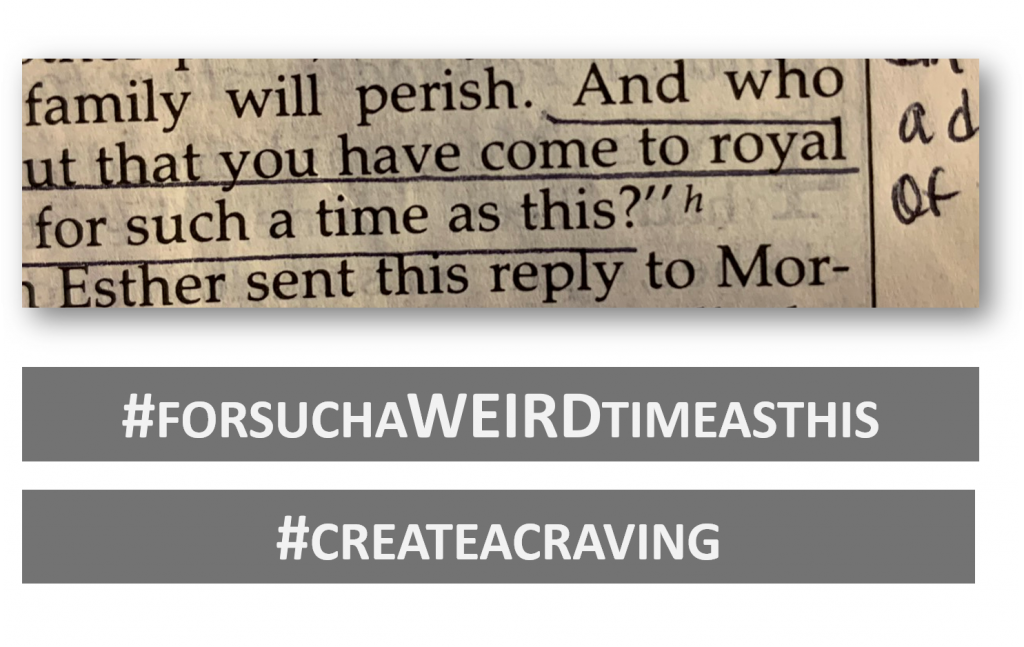
Thank you for being a part of this journey to lean into such a weird time as this, to listen, to feel, to hear what God is saying. Thank you for accepting the invitation to redeem this weird time that we find ourselves in, to build a dependence on God’s Word that would have otherwise not happened.
Our hearts are the intended targets of the message of God’s Word. But, it has to go through our brains to get there. And of course, the written form of God’s Word is a lot of text. In fact, the Bible clocks in a bit longer than the novel Les Misérables and a bit shorter than the entire Harry Potter series. If you don’t classify yourself as a reader, that amount of text can seem pretty daunting. Actually, even if you do classify yourself as a reader, that amount of text can seem pretty daunting.
Gentle Exercise 2 of this “Create A Craving” effort for such a weird time as now focused on how the Bible wants to be experienced. The passages we explored showed that God does not want us to miss one life-changing drop, inviting us to a level of communication that is engaging, meditative, and interactive. But there is another angle to consider: How do we like to learn? The way we take in text and process information has more to do with our level of engagement with Scripture than what we might suspect. And it could also be the difference between invigorating Bible experiences and Bible time that we don’t really look forward to. We tend to gravitate to the default learning style of reader, but if that’s not your learning style, it may explain why Bible time is a struggle for you. If you’ve ever felt that Bible reading was boring, consider this: it’s not you. It’s your learning style. More specifically, it’s a mismatch of your learning style with your Bible engagement. This is why it may be helpful, early in this Create A Craving effort, to understand the type of learning you tend toward…your learning style if you will.
I actually didn’t know my learning style when my Perfect Storm of events gave me a craving for Scripture that changed the trajectory of my life. But I got lucky, well, divinely and mercifully directed actually, and happened upon an approach to Scripture that lit me up. We’ll touch on that approach in the next couple of gentle exercises. The reason the approach was so transformative is that it tapped into the way I like to ingest information and helped me approach Scripture in a way that catered to how I am wired. It wasn’t until recently that I’ve understood the learning style connection.
Here’s the thing: I’m not a Bible scholar nor an educator, but I believe that different genres of Scripture are designed for different learning styles. It would make sense that God would build a gateway into Scripture that caters how each of us are wired to comprehend. Understanding our learning style and applying it to our interaction with God’s Word can open us up to an invigorating level of Bible study that we never thought attainable.
So, Gentle Exercise 3 is simply a document to introduce you to four basic learning styles (and by the way, there are myriad philosophies about learning styles and more nuanced styles than four). The exercise I’m asking of you is to simply read through the document and see which learning styles (you may have more than one) resonate with you. You’ll also see some suggestions for how to apply each learning style to a more engaging Bible study experience. Here’s an overview of the doc:
Page 1: A brief introduction to four basic learning styles. Simply read about each style and note which you think you cater to.
Page 2: A brief treatment of mashing up learning styles with the three basics steps of inductive Bible study (observe, interpret, apply). Read through your learning style and try any of the suggestions for stepping into effective Bible study.
One more thing. Do an online search for “my learning style” and you’ll find cool tools for evaluating and better understanding your personal learning style. It is never too late to discover your learning style and to put that into practice.
Prayers!
![]()
Gentle Exercise 3: Learning Styles and Bible Study
Get all the gentle exercises, so far, here.